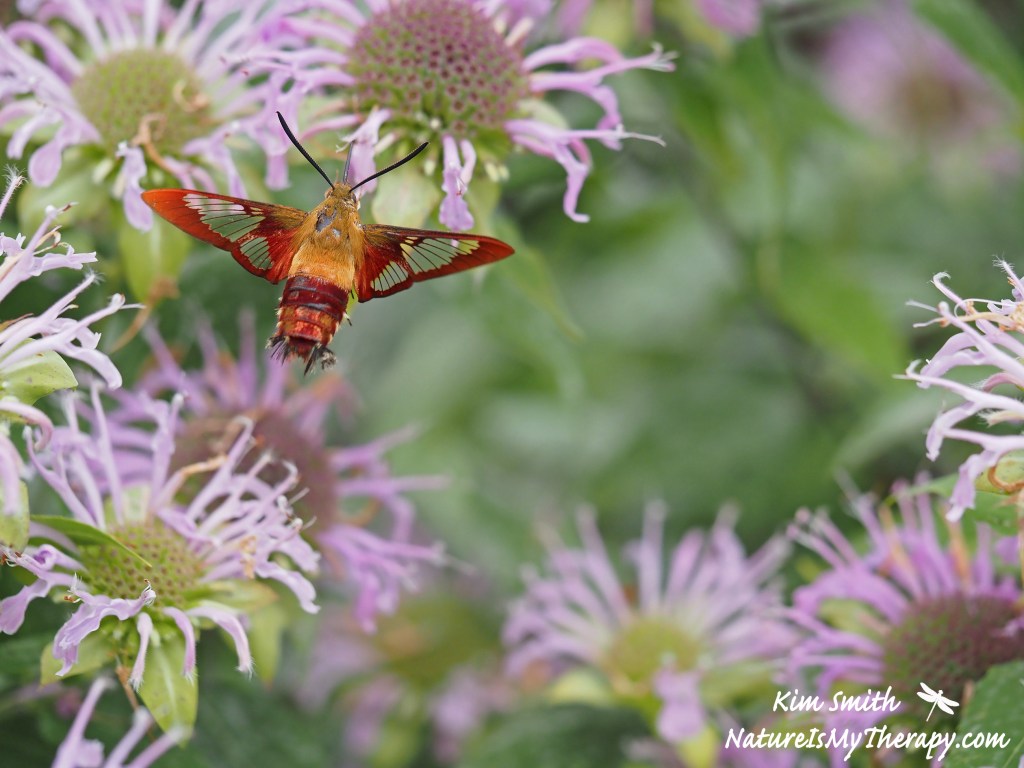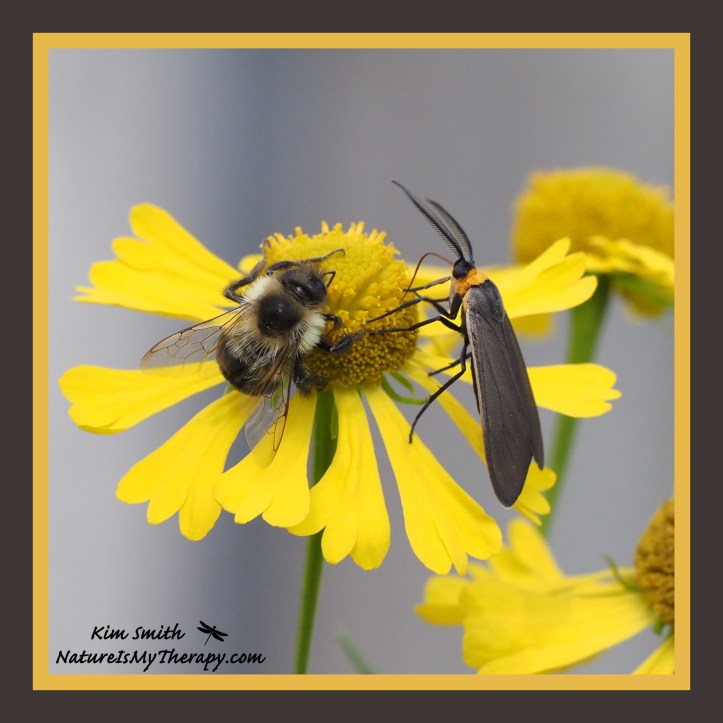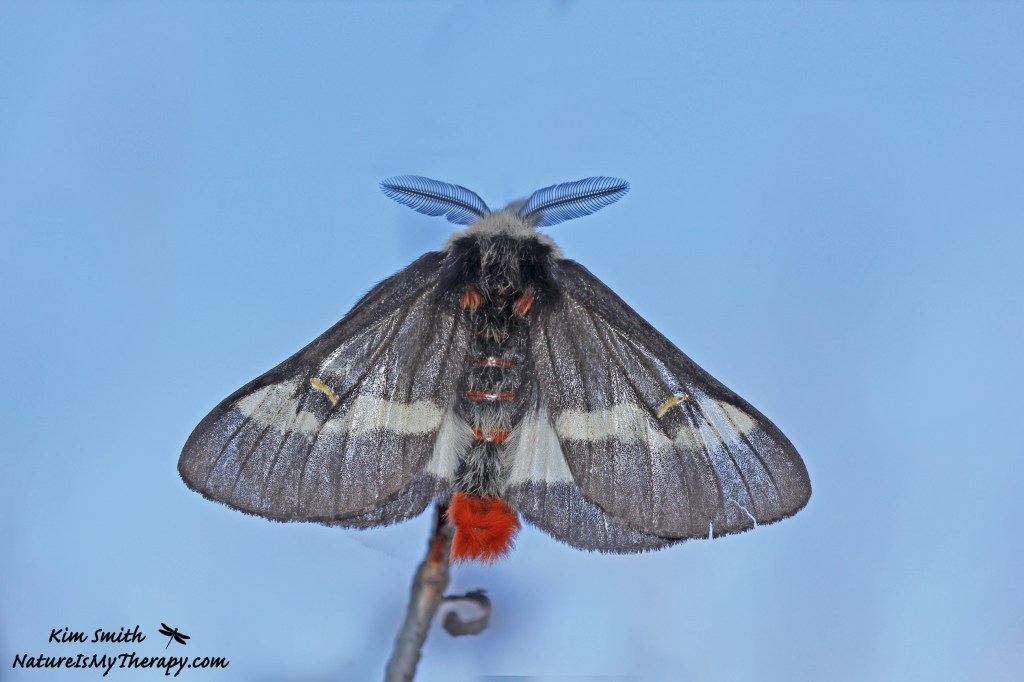
It’s National Moth Week, so I thought I’d take the opportunity to share some interesting tidbits about these important pollinators.
Huh? Pollinators?
Yes, just like butterflies do in the daytime, moths transport pollen between flowers as they feed on them (mostly) during the night. In addition to being important pollinators, moths are food for birds and other animals. Scientists estimate there are at least 150,000 species of moths worldwide.
Since most people writing about moths this week will probably focus on the typical night-flying species, I thought I’d show you some of the diurnal, or daytime-flying, moths. The one pictured above is a hummingbird clearwing moth. I caught this photo as it fed on the wild bergamot in my garden the other day. I happened to be standing up close to the flowers with my macro lens on (as I often am…), waiting for something to happen, and suddenly this beautiful moth flew right in front of me and spent a couple minutes flitting among the flowers. I used a fast shutter speed to freeze the motion of the wings, which allows us to see the namesake clear wing panels.
Here’s a yellow-collared scape moth sharing a sneezeweed flower with a bumble bee, also in my garden.

Next up we have the buck moth, a member of the silkworm family, with a wingspan of 2-3 inches. Here in Ohio, the adults can be seen flying around oak savannas at mid-day in the early fall; they don’t have mouthparts and only live for a week or so, just long enough to mate. As you can see, this is a male with huge feathery antennae that allow him to detect the female’s sex pheromones. If you’re interested, here’s some info about a study that suggests that females prefer males with big ones…antennae, that is. And here’s more detail about the buck moth life cycle, with lots of photos (from the University of Florida Dept of Entomology).

And last but not least is one of my favorite little moths, the ailanthus webworm. I often see these in my garden, and they could be easily mistaken for beetles if you hadn’t seen them before. I’d noticed this one during the afternoon today but didn’t try to take photos because the sun was so harsh. But just before dusk I found it again, actively feeding on my common boneset. I took a few photos and then got a bit of video; I think the video came out pretty nice since I had the tripod this time (I’m so lazy about taking my tripod with me!).

I was happy to capture the curled proboscis. Here’s the video:
Finding and photographing moths in the daytime is much easier than at night, although there are some stunning nocturnal moths that are very much worth seeing if you can manage the late hours and have a good light setup. If you want to read about some nocturnal moths, check out this post I wrote a few years ago about the thrills of nighttime mothing when I attended Mothapalooza in southern Ohio. (I’ve got plans for a trip to see dragonflies in Brazil in January, and the place I’m staying has a moth wall setup so I’ll be in insect heaven for an entire week — odes in the day and moths at night. #NoTimeForSleeping)
But whether they fly in the day or at night, all of these moths are important to helping sustain human life on this fascinating planet. I hope you’ve enjoyed getting to know them a bit better.
Happy National Moth Week!

Wow, this is a fantastic post! Last year after some excess rains, we had an abondance of White-lined sphinx moths here (which I never noticed before). They are so fantastic to watch. I am seeing them again here this year. And oh my, you are going to Brazille for dragonflies? I just love dragonflies!! 😊
LikeLiked by 1 person
Thanks, Lisa! Yes, I’m going to Brazil to watch dragonflies in January…very excited about the trip!
LikeLiked by 1 person
Such pretty moths! I only see white and tan ones here but I do not have the plants that attract them. It is nice to see your pictures!
LikeLike
I love learning from your blog Kim. I always feel like you’re with us explaining it all to us on a nature walk. I even learned something from a reply to one of your other readers: I didn’t know the boneset has a lovely fragrance, going to go sniff some of ours this afternoon!
LikeLike
Ginny, thank you for the nice comment, and I’m so glad you enjoy my posts!
LikeLike
Wonderful photos and information, as always, Kim. I learn so much! I especially loved the video of the webworm moth feeding on the boneset flowers, mostly because the way it feeds is fascinating (as is the fact that the proboscis is curled up when it isn’t feeding) but also in small part because I recently discovered that new-to-me wildflower growing alongside a pond where I walk my dogs here in Vermont.
LikeLike
Glad you liked it! The next time you walk past a patch of boneset, make sure you smell it. It has a lovely sweet fragrance and there are always so many insects on it.
LikeLike
Kim! You are going to Brazil? WOW! These are gorgeous photos — I love your National Moth Week post. Our Tuesdays in the Tallgrass prairie group is doing a Mothapalooza each month this summer — we are learning so much about the “after dark” moths. What a good reminder of all the great flying moths that love the daytime! Thank you!!! Safe travels!
LikeLiked by 1 person
Thanks, Cindy! My Brazil trip isn’t until January, and of course there will be uncertainty about travel conditions right up until the last minute (covid, monkey pox, airline problems, etc), so I’m trying not to get too excited in case I have to cancel it. But I’m starting to study their dragonflies now!
LikeLike
[…] the fact that I read a lovely blog post this morning on this very subject by Nature is My Therapy: https://natureismytherapy.com/2022/07/26/moths-not-just-for-after-dark/ So thank you Kim for the timely […]
LikeLike
Thanks, Nicky! Everyone, go see her pictures of moths from her UK garden — very cool stuff.
LikeLike
Very nice series of images Kim! Enjoyed seeing them!
LikeLiked by 1 person
Thanks, glad you liked this!
LikeLike
Absolutely love the webworm moth – what a stunning insect!
LikeLiked by 1 person
Yes, it sure is…thanks for commenting. 🙂
LikeLike
The hummingbird clearwing is fabulous! But so are they all. I love moths, except when they infest my wool carpet 😡. Those feathery antennae are gorgeous. I really wanted to see the wings spread on that webworm moth and what they look like in the video. If you get a photo or video of it please share. So glad you are enjoying the insect season.
LikeLiked by 1 person
Glad you liked it Ardys! I have never seen the wings spread on the ailanthus webworm moth, and a quick internet search didn’t turn up any photos of the wings spread either. It’s a very small moth too (half inch ), so when it flies it’s hard to get a picture.
LikeLiked by 1 person